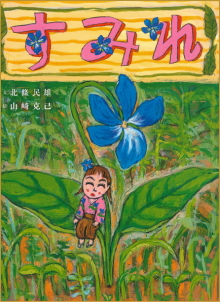イベント詳細
2015.08.01
2015年度ギャラリー展のご案内
※イベントは終了いたしました
北條民雄生誕100年絵本「すみれ」刊行記念 原画展

国立ハンセン病資料館は、北條民雄の童話『すみれ』を原作として、今年3月に絵本『すみれ』を刊行しました。そしてこの度、関係各位のご協力を賜り、絵本『すみれ』の原画展を開催する運びとなりました。
北條民雄の名を不朽のものにしたのは、
執筆時から30、40年先の医療で取り入れられることになる「障碍の受容」について、北條はその核心を突いていたことになります。
こうしたメッセージを、童話『すみれ』からも読み取ることができます。「誰も見てくれる人がなくても、わたしは一生懸命に、出来る限り美しく咲きたいの。どんな山の中でも、谷間でも、力一パイに咲き続けて、それからわたし枯れたいの」というすみれの言葉は、佐柄木のいう「復活」に通じます。また、それを聞いた老人が「さうだ、わしも、町へ行くのはやめにしよう」と思いなおすのは、佐柄木の話を聞いた尾田が「やはり生きて見ることだ」と強く思うのと同じです。
現在は薬によって治る病気となったハンセン病は、『いのちの初夜』の時代にはほぼ不治の病でした。そして病気に限らず、いつの時代でも絶望や苦痛は人びとを打ちのめします。子どもたちがいずれ困難にぶつかったとき、絵本『すみれ』が大きな励ましになることを願ってやみません。
- 作者紹介 -
文・北條民雄(1914-1937)
徳島県出身。本名
小説『いのちの初夜』で知られる北條は、1934(昭和9)年5月に全生病院(現 多磨全生園)に入院し、3年半後23才の若さで亡くなりました。川端康成に師事し、人間を描きたいと願って小説や随筆を数多く手がけた北條には、童話は生涯に2作品しかありません。童話『すみれ』はそのうちの1つで、1935年1月、院内の子どものための雑誌『
絵・山崎克己(1954- )
東京都出身。彫刻刀で紙を彫る紙刻繪で作品を発表している。漫画集『餃子読本』(思潮社)で日本漫画協会優秀賞(1986年度)を受賞。絵本に『エイサー!ハーリー』(フレーベル館)、『よりみちせんべい』(農文協)、『おにぎりゆうしゃ』(イースト・プレス)、『やまびこポスト』『うどんドンドコ』『ふろしきでんしゃ』(BL出版)、『せかいいちたかいすべりだい』(文 加藤志異・大日本図書)など。
童話『すみれ』のあらすじ
音吉じいさんは人里離れた山の中に一人で住んでいました。妻に先立たれ、息子とも離れて暮らしていたため、寂しさに耐えられず町へ引っ越す決心をしました。そんな時、庭の片隅に咲く小さなすみれを見つけます。その美しくも寂しげな様子が気になった音吉じいさんは、出発を延ばして世話をするうちに、すみれと心が通うようになっていきます。すみれの境遇に同情する音吉じいさんに、すみれは自分が幸福な理由を語るのでした。
開催概要
【開催日時】
2019年9月10日(火)から9月29日(日)
【会場】
当館1階 ギャラリー
【開館時間】
9時30分 から 16時30分(入館は16時まで)
北條民雄生誕100年 |
|
 |
 |
 |
 |
 |
 |
